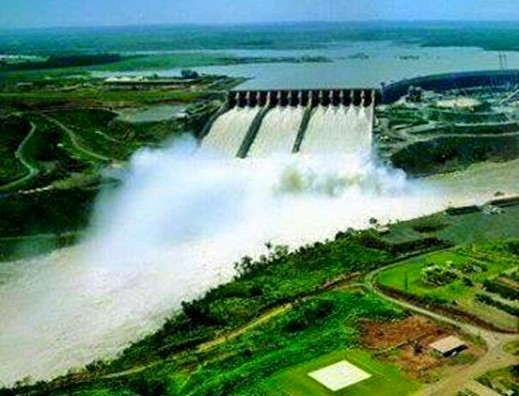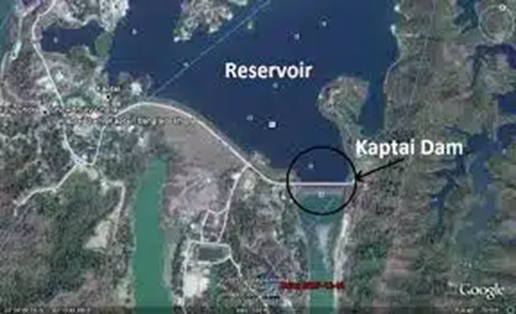
The blue shadow of the sky in the wobbly water. In the blue eyes of the tourist, the distant green mountains, the water of Kaptai lake and the color of the sky are monotonous. Shaking water of the man-made Kaptai Lake. Born from Lusai Hill, the stream called Karnaphuli flows into the sea. Kaptai Hydroelectric Project in Erie. Karnaphuli’s stomach was torn open and a mud embankment was performed. Electricity is generated by pumping out the dammed water. Hence the name hydroelectricity.
There is no end to people’s interest and political criticism about this controversial dam. Due to the wrong politics of the Pakistani rulers, discrimination against the hill communities and cost per unit of electricity production, no other government had the courage to undertake hydropower projects in independent Bangladesh. It took many years for the mountain peace that started to be disrupted around the Kaptai dam during the Ayub period to return to peace.

Bengal had just been partitioned in the early 20th century. East Bengal and Assam are newly independent provinces. Dhaka got the status of the capital. Chittagong is the largest port city. The initial survey was completed in 1906. In the western world, the business of electricity was booming. The light bulb invented by Thomas Alva Edison was a royal affair. America is considering several hydroelectric projects including the Hoover Dam. Electrification is underway across America. England, Germany are not far behind. Buckingham Palace replaces hazak with chandeliers.
Meanwhile, King Edward VII’s Indian delegation is looking for electricity in Calcutta, Delhi, Dhaka. But where is the electricity? Its production has not started everywhere!
But lucky Calcutta metropolis. Three power stations were built by 1906 to supply electricity. Mackinnon and Mackenzie Cotton lit the experimental electric lamp on 24 July 1879. Then, in the late 19th century, the first electric streetlights were installed on Imambagh Lane. On a small part of the road. Only in the area adjacent to Princep Ghat of Hooghly River. This is from 1899. In addition, the British Raj started a generator to provide electricity to a tramline in Bombay.
Karnaphuli river in the south east corner of East Bengal. The highest flowing river on the eastern border of British India. The speed of the current did not escape the attention of the English engineers. It originates from the Lusai Hills in Mizoram and flows 270 km to join the Bay of Bengal. This can be the optimal water stream for power generation.
Unfortunately, due to the cancellation of the partition of Bengal and various bureaucratic complications, East Bengal fell behind in electrification. In 1923, the Karnaphuli project again came to the attention of Sarkar Bahadur. Then another twenty-three years passed. At the end of the Second World War, British engineers suggested the construction of a dam in the Barkal area during the farewell phase of the British. After the independence of India, in 1950, Marge Randall, as an expert engineering consultant, gave the final advice on the construction of the dam to the consulting engineer Chillard. It is 45 km upstream from Kaptai. However, in 1951, Chief Engineer of Irrigation Department, Government of Pakistan, Khawaja Azimuddin removed the dam from Randall’s design and brought it to the present location.
Whether the error lies here is a matter of research. Perhaps as much research as should have been done on Kaptai Dam. But it is difficult to say that the selection of the place was completely correct. If a reservoir or an artificial lake is created due to the construction of a dam, a large area will be submerged in water. Engineers can understand this in advance design. Engineers also report in advance the announcement of how much cultivable land will be lost by identifying those areas. How many towns will be lost, how many people will be evicted can be calculated from the design. It is the responsibility of local politicians and federal authorities to understand the extent of the damage and help build dams.
President Iskandar Mirza ordered the construction of Kaptai Dam in 1957 without considering these calculations. The dam was started under the management of a US construction company called Utah International. After coming to power in 1958, Field Marshal Ayub Khan personally visited the dam area. The construction of the dam proceeded in a fast parade, ignoring the demands of the local residents due to the strength of the military. Such a huge construction project was completed in only five years during that period. Politics tells a different story when it comes to engineering breakthroughs.
Chakma, one of Pakistan’s smallest ethnic groups, faces severe losses. Lakhs of acres of cultivated land (jum cultivation) were destroyed and lakhs of hill tribal people were displaced. Seventy percent of it is the Chakma community. 40,000 Pakistani Chakmas took refuge in Arunachal Pradesh, India. Interestingly, Indian Prime Minister Jawaharlal Nehru did not oppose Kaptai Dam at all despite the pressure of this increased population. Because he has eaten politics since birth. Panchta had already done it. He knew that Pakistan would have to burn in the fire of Chakma treason for the rest of his life. Although it was partly true. Independent Bangladesh had to burn in the fire of remaining hardships.
Roughly the construction was completed in sixty-two years. The main embankment is constructed of earth. Installation of spillway, penstock and 40 MW Kaplan turbine generator is completed. The length of the earthen embankment stands at 670 meters or 2200 feet. About 46 meters or 150 feet wide. There are 16 gate spillway inside it.
By doing this, the expense account increased to 503 million rupees. Funding was provided by the United States, the Overseas Economic Cooperation Fund and the East Pakistan Provincial Government. What is noticeable is that the central government has not given any money.
Production capacity has not increased for a long time. The capacity was increased to 50 MW in 1982 and another 50 MW in 1988. At present, the production of such a large project is only 230 MW.
One of the objectives of any hydroelectric dam project is to supply water to cultivated land along with generating electricity. But the Kaptai Dam did not bring success in agriculture. Instead, 240 square kilometers of cultivated land has been destroyed. Which is almost equal to the size of the entire Maldives (about 80 percent).
Author: Professional Engineer, working in global engineering consulting company WSP Canada
